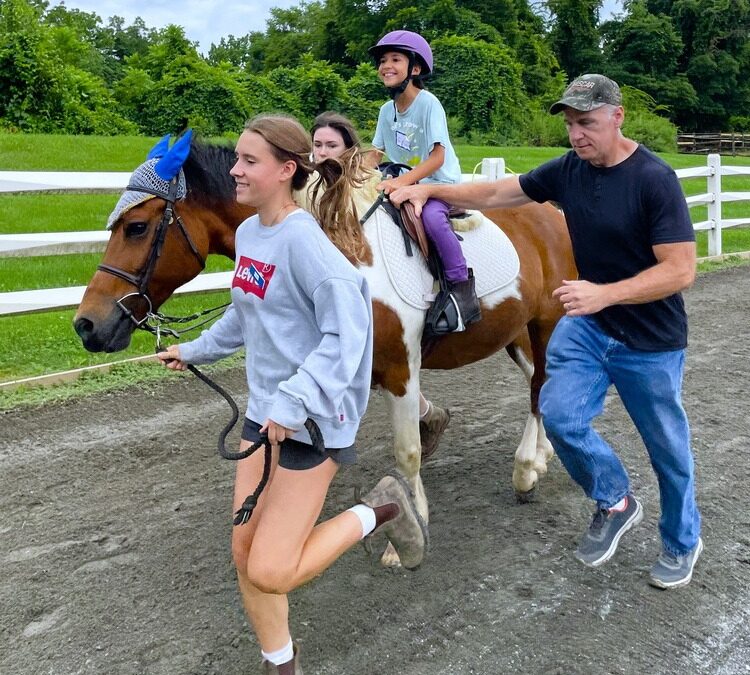
by Nancy Jaffer | May 9, 2025
Mane Stream, which offers a diverse program of equine-assisted activities, therapy services and educational initiatives, is seeking volunteers age 14 and older. The non-profit in Oldwick, N.J, has a mission to improve the quality of life for those with physical, developmental, emotional and medical challenges.
It is a Premier Accredited Center of PATH, the Professional Association of Therapeutic Horsemanship International, which provides education, accreditation and resources for the equine-assisted activities industry.

Mane Stream Volunteers Charli Auerbach of Bedminster, Shannon Santoro of Califon and Jarret Hansen of Randolph assist a happy camper riding Joey.
Volunteers are needed to groom and tack the horses and assist riders and therapy clients every weekday morning and afternoon, as well as Saturday mornings. Prior experience with horses is not necessary, This is a nice addition to a college resume, high school service requirement, or a rewarding activity for the newly retired.
One-hour online orientations are held every other week at 3:30 p.m. After that, new volunteers will be scheduled for hands-on training to ensure the safety of all participants. The orientation provides an overview of the programs and will explain the responsibilities of a Mane Stream volunteer. The hands-on training will involve grooming as well as tacking up for both adaptive riding and therapy, which are very different.
Register at the website www.manestreamnj.org, or call volunteer coordinator Emily De Jong at (908) 439-9636
by Nancy Jaffer | May 16, 2025
A free online webcast on equine endocrine disease will be offered at 8 p.m. May 19. Those who register can also take advantage of a link to a recorded version of the presentation at a later date. The seminar is presented by Kentucky Performance Products and The Horse.
This webcast will the most current information on causes, diagnosis, and treatment of the common equine endocrine diseases: equine metabolic syndrome (EMS), insulin dysregulation (ID), and pituitary pars intermedia dysfunction (PPID, formerly equine Cushing’s disease).
Discussed will be dynamic testing (TRH stim and oral sugar test) compared with taking fasting baseline blood samples for diagnosis. There also will be information on how endocrine diseases affect many body systems beyond laminitis. Systems affected include the musculoskeletal system (suspensory disease, osteochondrosis, osteoarthritis, and laminitis, for example), reproductive, respiratory, and cardiovascular. The webinar will examine current treatments, including supplements, medications, shoeing, icing and others.
Click here to register.

by Nancy Jaffer | May 11, 2025
What do you call a horse who has never toppled a rail in the show jumping phase of eventing?
You call it Lordships Graffalo, who won his second Badminton (the first was in 2023) on Sunday with a clear trip over the painted poles to move up from second to first and set a record. No other horse has won Badminton twice with a year’s gap in between.
Ros did it without her trainer and friend Caroline Moore, who died of cancer in March. That made the winning moment doubly emotional.

Ros Canter and Lordships Graffalo in triumph. (Photo courtesy Badminton Horse Trials)
The leader after dressage and cross-country, 2024 Kentucky 5-star winner Cooley Rosalent, had a single rail down to drop her to second place. Her rider, Oliver Townend, has been second five times in the British 5-star. He had a close call in the morning when she was held in the horse inspection, but then permitted to compete. His other horse, Ballaghmor Class, also was held but did not return for re-inspection.
Third went to Ireland’s Austin O’Connor on the 2024 Maryland 5-star winner, Colorado Blue.
World Champion Yasmin Ingham, fourteenth after cross-country, withdrew Rehy DJ before the final horse inspection.
Click here for results.
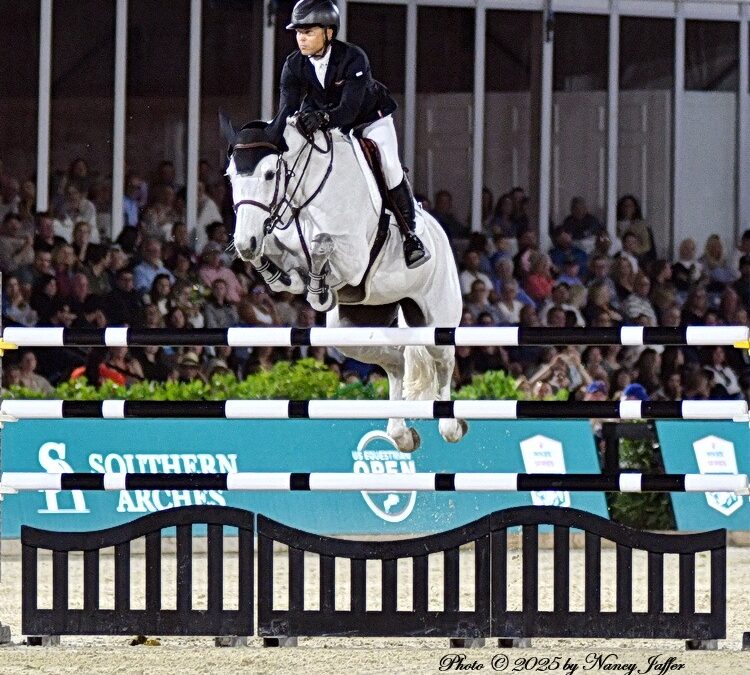
by Nancy Jaffer | May 6, 2025
The U.S. can claim the top riders on both the FEI show jumping and eventing ranking lists.
Kent Farrington just took the first place ranking on the Longines show jumping roster, succeeding Sweden’s Henrik von Eckermann, who held the spot for a record number of months, since August 2022. It is Kent’s second time as number one; he also was in that position in 2017.
Henrik is now third, behind Great Britain’s 2021 Olympic individual gold medalist, Ben Maher. McLain Ward is the second-highest ranking American, in eighth place.

Kent Farrington on Greya. (Photo © 2025 by Nancy Jaffer)
A few days ago, Boyd Martin was named number one for eventing. While he is the most visible U.S. eventer with a huge social media presence, Boyd Martin was only number two on the FEI world ranking list. That is, until Thursday. With the new month, he becomes the first American to make the top spot on that roster since Kim Severson did it 21 years ago.
Boyd, with three horses in the top 10 of last weekend’s 5-star Defender Kentucky event, called his elevation, “a huge honor and privilege to be named the number one rider in the world in eventing. It’s a goal I’ve been chasing for decades now. Many of my idols, who are champions in the sport and riders I’ve always tried to emulate, have accomplished this honor at some point in their careers.”
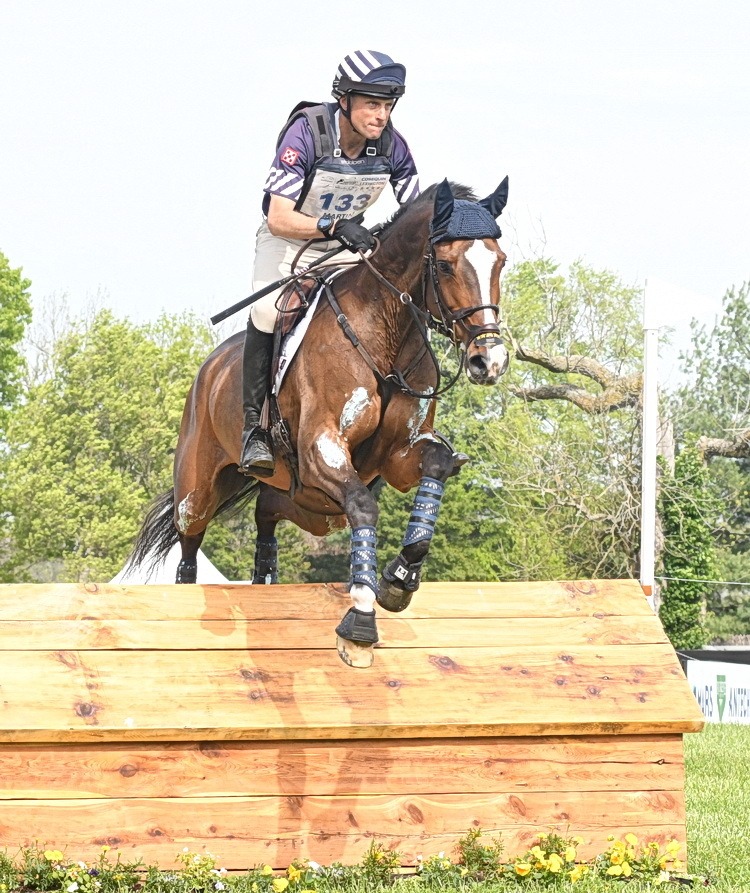
You can’t miss the trademark look of determination on the face of Boyd Martin aboard Commando 3. (Photo © by Nancy Jaffer)
Boyd added, “It’s really a humbling moment, and even though it’s my name on the list, I would not have been able to do it without the incredible horses and owners, as well as my dedicated team working day in and out in the stable. Lastly, to share this with my wife and kids, who have been with me on this journey every single day from the very beginning, is really special.”
While Boyd’s promotion is good news for U.S. eventing, the bad news is that you have to go down to number 30 to find the next-highest ranked U.S. rider, Jennie Branningan. Since one person does not make a team, U.S. eventers have some hard work ahead of them. But now they have some inspiration.
The Para Dressage ranks also include a number one standing for the U.S., in Fiona Howard and Kate Shoemaker is number four as the country continues to excel and show the world how it’s done in that discipline.
In Grand Prix dressage, however, the U.S. wasn’t even in the top 10. The country had only one rider in the top 20, Adrienne Lyle, who is nineteenth. Next-highest is Anna Marek, twenty-seventh. Denmark’s Cathrine Laudrup-Dufour continues to lead the standings, with World Cup champ Lottie Fry of Great Britain moving up to second, passing Germany’s Isabell Werth.
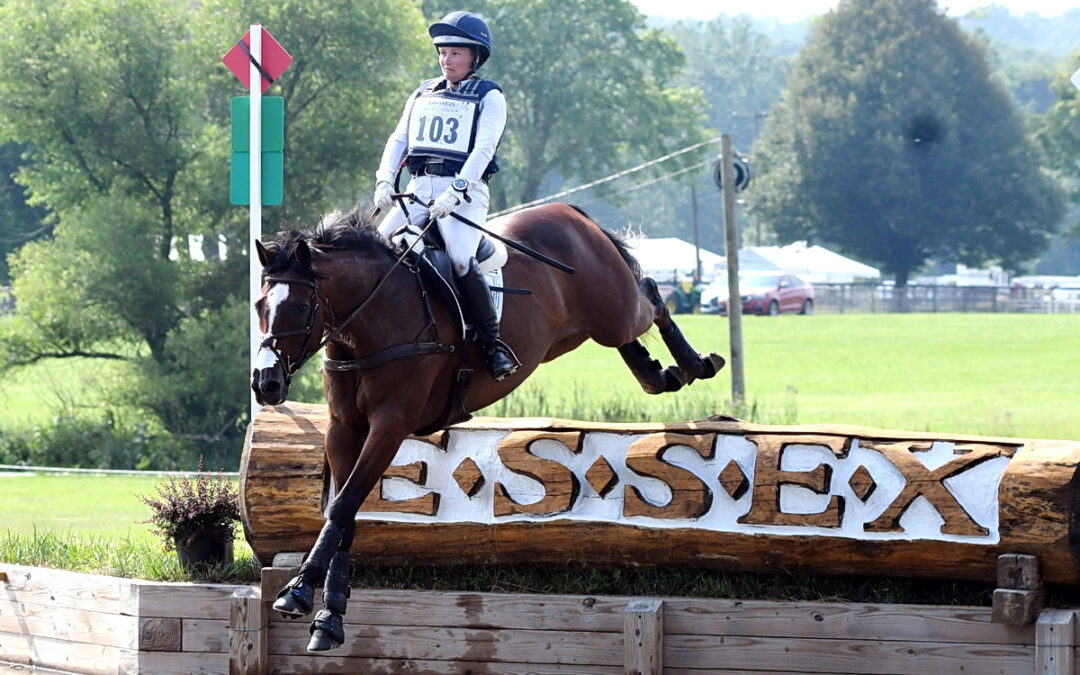
by Nancy Jaffer | May 2, 2025
Since the 1960s, there have been a few different versions of the Essex Horse Trials, though its name has always meant something in the world of three-day eventing.
It started as a local event in New Jersey, growing to become one of the country’s best competitions at U.S. Equestrian Team headquarters in Gladstone, then taking a long nap after its 1998 edition when construction of a golf course put a dent in the land available for cross-country.
After a decision was made to revive Essex with new energy, it reappeared in 2018 at Moorland Farm in Far Hills, home of October’s popular Far Hills Race Meeting.. A few years later, Essex divided its time over two days, between the USET Foundation for dressage and show jumping and the impressive terrain of Moorland for cross-country.
On June 1, it will be a one-day event, with every phase at Moorland. As organizer Marilyn Payne points out, once the action gets under way, spectators can view each segment of the competition just by taking a short walk between the arenas and the course at any time.
“It will be a three-ring circus,” she chuckled.
Prime spots by the water jump are available for tailgating. Make arrangements at essexhorsetrials.net.

Tailgating by the water jump is a prime viewing spot. (Photo © 2023 by Lawrence J. Nagy)
Marilyn rode in the first Essex 57 years ago, and ever since hasn’t missed being part of the event in some capacity, whether it’s as a competitor, trainer or official. When the two-day format became too difficult for both participants and organizers, it appeared the event might once again fade into the mists of history.
But Marilyn wasn’t going to let that happen and stepped up with the one-day concept.
Although some of the country’s best eventers have competed at Essex since its founding in 1968, the emphasis in the new iteration involves helping build the base of the sport.
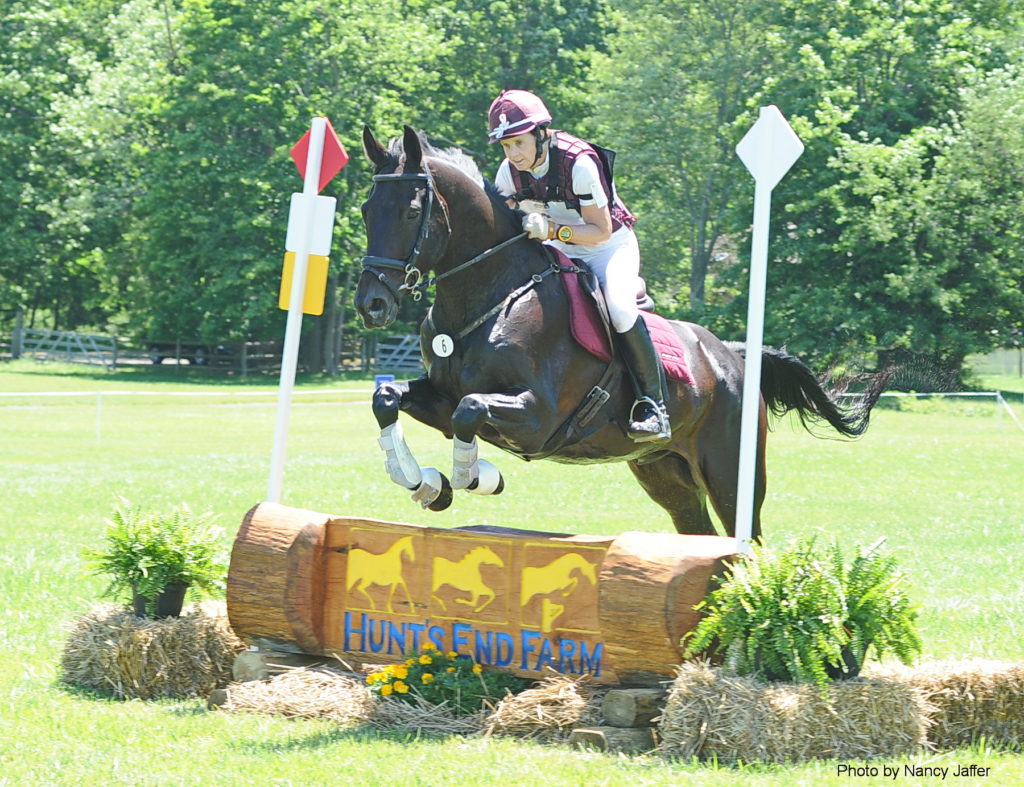
Marilyn Payne in action at Essex. (Photo © by Nancy Jaffer)
Marilyn pointed out that Essex is “a stepping stone for people. They use it as part of their program. You need an event here; you don’t want a gap. It’s convenient because you can come and go in the same day. I’m so excited to be able to offer it to all these younger riders and horses to get started. There aren’t enough places to do that.”
The upper ranks of eventing have to build on the lower levels, but the opportunities to establish a base of competitors too often are lacking in an era when open land is more valuable for development than for equestrian purposes.
“We’re losing events a lot of times just because good land is being developed,” Marilyn pointed out.
Consider that the only two riders representing the U.S. in the top 10 at the Defender Kentucky 5-star last weekend, Boyd Martin and James Alliston, started eventing in Australia and England respectively. So it’s significant that Essex is adding a starter division for people and horses seeking an introduction to a discipline that might seem intimidating at the higher levels, but is very welcoming when the test is simpler.
“We have fox hunters, trail riders and show jumpers coming; it’s exciting for them to try it and see what it’s all about,” said Marilyn.
“Once you get hooked, you get hooked. It’s so much fun.”
Since the event, which has Preliminary as its highest level, will be limited to 150 entries, Marilyn urges people to register early to make sure they don’t get shut out. Courses will be designed by Morgan Rowsell, who builds cross-country routes all over the country.
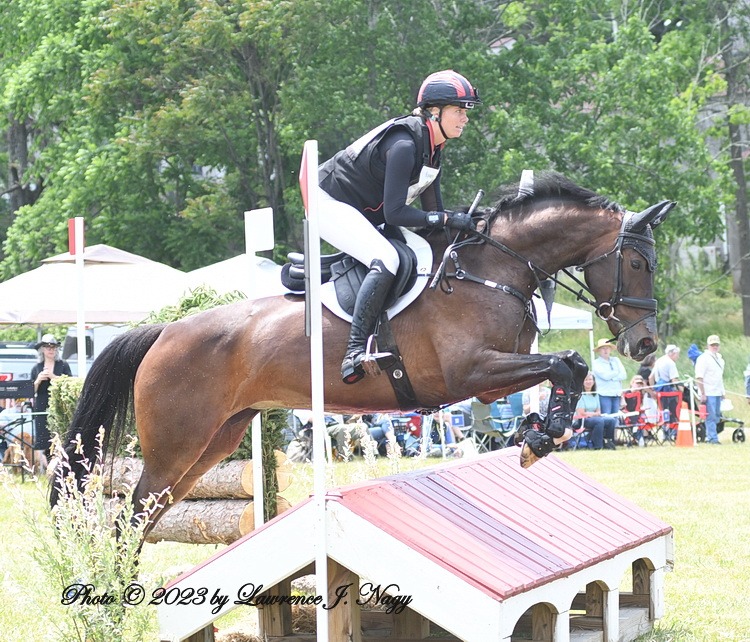
Olympian Caroline Pamukcu is among the well-known riders who have competed at Essex over the years. (Photo © 2023 by Lawrence J. Nagy)
Fundraising for the starter division’s cross-country fences is ongoing, and those who wish to contribute can contact Marilyn directly at applewoodfarm@comcast.net or go to the website at essexhorsetrials.net. Anyone interested in volunteering for a host of different jobs, whether as fence judge, ring steward or other positions should get in touch with Marilyn or apply on the website.
“They don’t have to know how to do anything; we will teach them,” said Marilyn about new volunteers.
Presenting sponsors for Essex are Pure Insurance, which is returning to support the competition, and Land Rover of Parsippany, a full-service dealer of luxury brands that is expanding its involvement. Other sponsors include Kienlen Lattmann Sotheby’s International Realty, Hunt’s End Farm, Hewitt Home Heating, Purina Animal Nutrition in conjunction with Somerset Grain & Feed and Sergeantsville Grain & Feed, and Corcoran Sawyer Smith real estate.
Dr. Greg Staller’s Running ‘S’ Equine Veterinary Services sponsors a riders’ tent that is also open to horse owners and grooms, so they have a place to take a break and help themselves to food.
Those who compete at Essex, Marilyn pointed out, “are going to be treated like big-time riders, even though they’re just starting out.”
Essex gives back beyond the equestrian scene, benefitting the Life Camp in Pottersville, which provides an enriching summer day camp experience for 300 youths daily for six weeks during July and August. Campers between the ages of 6 and 13 come from the greater Newark public school system, as well as from Newark Charter School Programs. A group of the children attend the horse trials and have a ball with a picnic by the water jump. There’s even a pony available for petting, offering most of the youngsters their first equine contact.
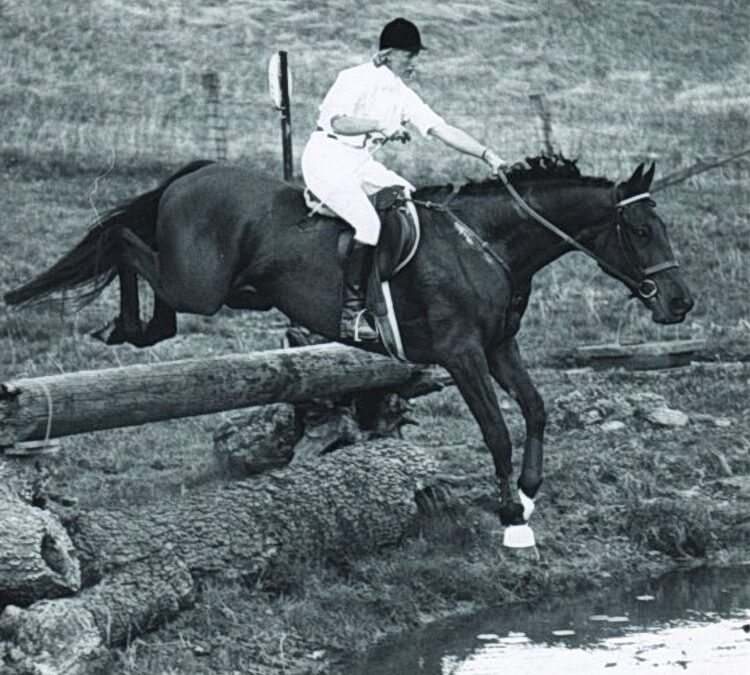
by Nancy Jaffer | Apr 29, 2025
Lana duPont Wright, who made history as the first female eventer to ride in the Olympics, died at her home in Chesapeake City, Md., last week. She was 85.
Olympic eventing, which had been contested by U.S. military teams through 1948, was still limited to male participants until 1964. That was when Lana, who grew up in a foxhunting family, became part of the U.S. silver medal squad at the Tokyo Games. Demonstrating her grit and determination, she continued on the demanding cross-country course despite having two falls. (In those days, you were allowed to remount and continue after hitting the ground.)
“It was quite an honor to have been part of such a successful team,” she recounted, “particularly since it opened the avenues for many other woman participants in the Olympic three-day event thereafter.”
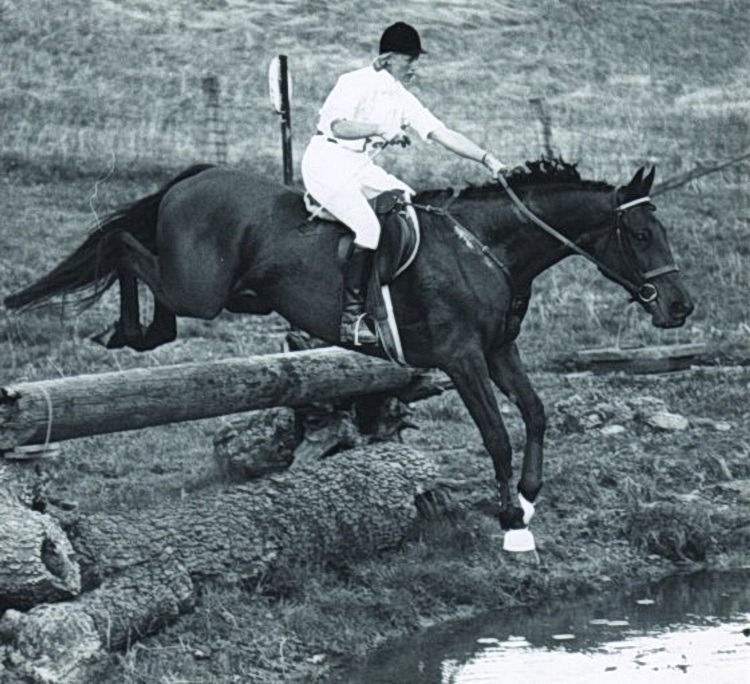
Lana duPont Wright in her eventing days.
When Lana switched disciplines, she went on to earn another historic medal as part of the 1991 U.S. pairs driving team, the first to take gold at a world championships.But her riding career wasn’t over. She competed in endurance and rode in the Pan American Endurance Championships. The endurance aspect was one Lana was passionate about in both eventing and driving, so it was a natural progression. She also continued foxhunting, which was the sport that gave her the basics of her career in her youth.
In 2012, she was inducted into the U.S. Eventing Association Hall of Fame. Three years later, she received the U. S. Equestrian Federation’s Lifetime Achievement Award.
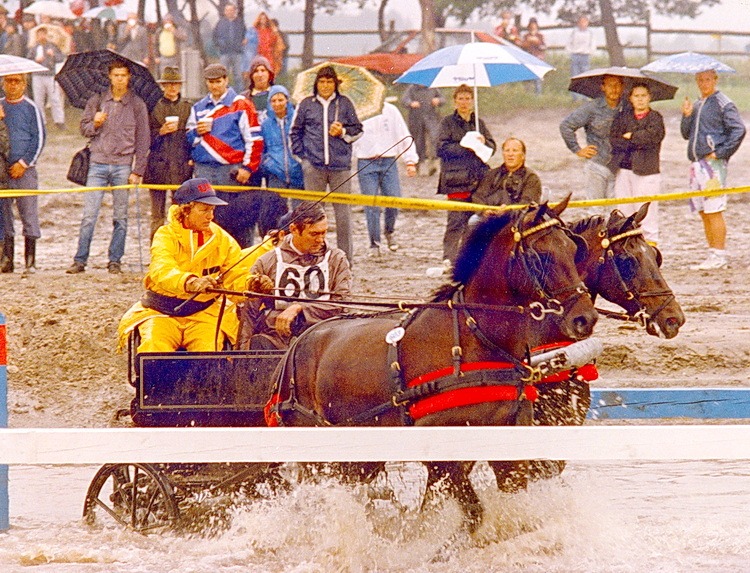
Lana Wright competing in the marathon at Fair Hill in 2013. Photo © 2013 by Nancy Jaffer
Lana shared her love of horses and knowledge with young riders through the U.S. Pony Club. She also served as co-president of the Fair Hill International board (along with the late Trish Gilbert) in Maryland for decades.
She is survived by her daughter Lucy Dunne (Michael) of Vermont and her grandchildren Wright Morris,, Beale Dunne and Ridgely Dunne. She was predeceased by her parents, Richard and Allaire duPont; her brother, Richard duPont Jr, her husband, Dr. William Wright and daughter Beale Morris.
A celebration of Lana’s life will be held Thursday, May 1 at 11 a.m. at St. Augustine Church, 310 and Mitton Road, Chesapeake City, MD. The burial will be held privately. In lieu of flowers, contributions may be made to Fair Hill International Inc., and sent in care of R.T. Foard Funeral Home, P.A., P.O. Box 248 Rising Sun, MD 21911.
by Nancy Jaffer | Apr 23, 2025
The U.S. Center for SafeSport has fired CEO Ju’Riese Colón in the wake of an investigation by U.S. Sen Chuck Grassley (R-Iowa) into the organization’s hiring of an investigator who subsequently was charged with rape.
The CEO, who was let go on Tuesday, assumed her role in 2019 to run the center created to combat sex abuse in Olympic sports. SafeSport became the target of criticism on several fronts, including delays in processing its caseload and what some of the accused called a lack of due process in the way its business was handled.
The tipping point came after former Allentown, Pa., vice squad officer Jason Krasley was hired by SafeSport in 2021, but fired in November 2023 when it was revealed he had been arrested for allegedly stealing money from a drug bust. Two weeks later, Krasley was arrested on charges involving rape, sex trafficking and other crimes. The Center went on to make changes in its hiring process.
The Center was founded eight years ago, when the Olympic movement was faced with abuse issues in several sports The most headlines were generated by the scandal at USA Gymnastics, where team doctor Larry Nassar eventually wound up in prison after being accused of sexually assaulting hundreds of female athletes under the guise of medical treatment.
Steve Silvey, an attorney who represents Athletes for Equity in Sport, commented about the SafeSport leadership change, “It gives little satisfaction to see the titular head of an organization fired as some sort of public sacrifice. Similar to firing a coach for a dysfunctional team’s performance. We have commented for many years that the entire SafeSport organization is an abject failure for all concerned: victims, the sporting community, the NGBs (National Governing Bodies) and the USOPC (U.S. Olympic and Paralympic Committee.)
He added, “SafeSport is lost, it may be too late to fix it and it is probably irretrievable. However, if the organization is genuinely interested in getting on track with the intended mission and finding its way to a proper path, then it is a good start but a complete spring cleaning and total reset is required.
“The Board needs to be reset, and the rest of any dysfunctional existing leadership should follow out the door. Now is both the time and opportunity for a major correction. Otherwise — it just smacks of a coach being sacrificed as strategic posturing and the root problems remain unaddressed. It also does nothing to correct the lives damaged or even destroyed by the root dysfunction. I suppose we’ll see, but we’re not holding our breath either.”
The U.S. Equestrian Federation requires competing members 18 and older to complete SafeSport training on line, along with officials and show managers. USEF has a 24-page document outlining SafeSport policy on its website.
SafeSport board chairperson April Holmes will lead board members in a management committee while they search for a new CEO.
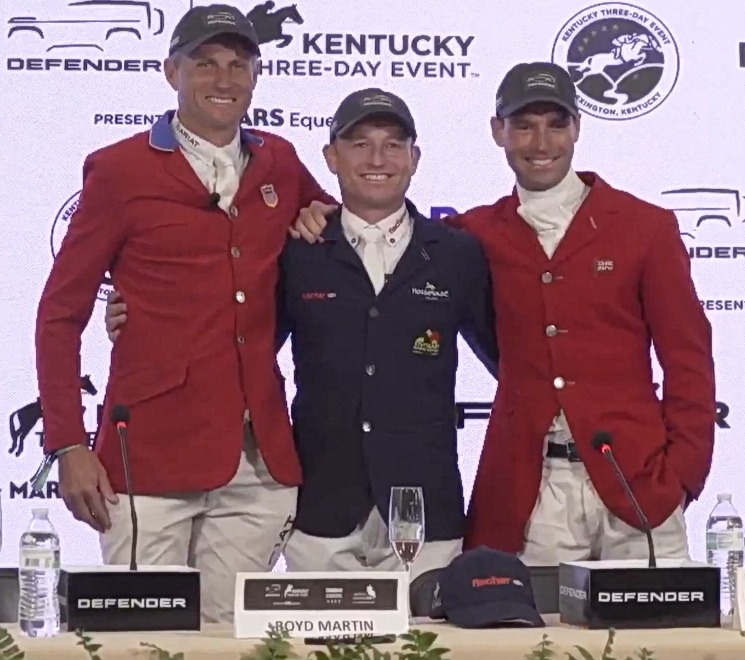
by Nancy Jaffer | Apr 27, 2025
Boyd Martin stood second with Commando 3 going into the show jumping finale at the Defender Kentucky 5-star three-day event on Sunday. The highest-ranked American in the competition knew he had just two chances — slim and none — of defeating the leader, Olympic champion Michael Jung on fischerChipmunk.
After a fault-free effort in the Rolex Arena, all Boyd could do was watch the leader’s ride and wait. His only hope, he recounted with his typical wry sense of humor, was that Michael either “had too much bourbon” at a club on Saturday night or “maybe he goes off course.”
But other than that, “I was just hoping for second place,” Boyd said. And that’s where he wound up, with 32.8 penalties, as the U.S. national 5-star champion for the third time in his career. He also was sixth with his Olympic mount, Federman B (40.6) and seventh on Luke 140 (44.7).
Following Saturday’s cross-country at the Kentucky Horse Park, where Michi picked up just 2.4 time penalties and Boyd logged 6.8, the gap between them widened from 7.4 penalties following dressage to 11.8. That meant Michi could knock down two fences in show jumping and collect time penalties before his lead was gone.
So when the German rider had a rail at the vertical obstacle that was just the third of 13 jumps on the Steve Stephens-designed course, the crowd of 11,000 gasped.
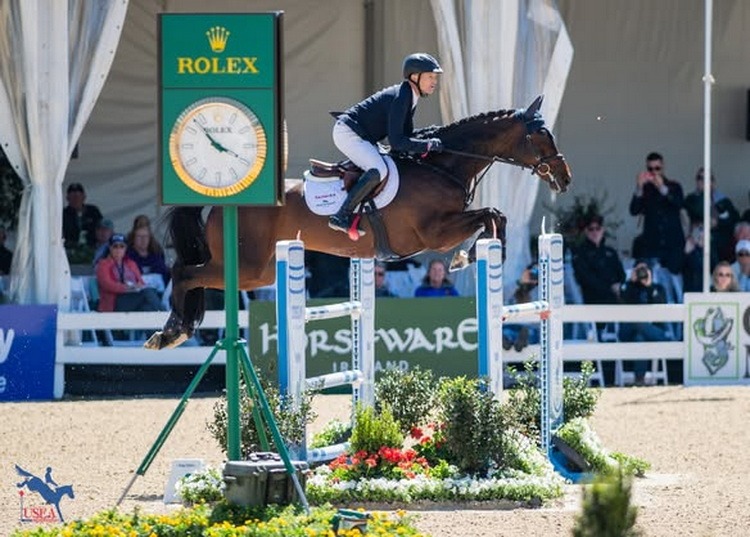
Michael Jung and fischerChipmunk on their way to victory. (U.S. Eventing Association photo)
As usual, however, Michi stayed cool.
Recounting his trip around the course, he said, “I start the round a little bit with a nice forward rhythm. I had a pole down very early; I said `okay…we had a long way, many jumps to do.’ I tried to give him a bit more balance.
“He’s jumping great. I tried to do seven strides into the last combination to get him a bit more on the hind leg and slow down a little bit, because it’s a big horse and just (on) the way to the entrance at the end of the course, he’s sometimes a little bit too much forward. It went well.”
That means he picked up the $123,000 winner’s share of the prize money.
Expressing his appreciation for the Kentucky Horse Park, Michi said, “I always had a lot of luck here. Without luck, you win nothing.”
His total was 25 penalties, nearly five more than when he set a record winning the event in 2022, but he still was a wire-to-wire winner, as they say at the racetrack.
In his first appearance at the park in 2015 before he became a legend, Michi won the world championship. Since then, he has collected three Olympic individual gold medals, most recently in Paris last year. His victory this weekend set a record as his fifth in the 5-star event. Kentucky Gov. Andy Beshear, who presented the trophy, told Michi, “If you win this one more time, you have to move to Kentucky.”
That might be okay with the champion.
“This place is amazing, so many big fields. I really like this place,” he said.
Finishing third with a clean trip on Et Hop du Matz (34.2 penalties) was Great Britain’s Harry Meade, who also was fourth with Graffenacht (39.6) after toppling a rail and collecting 0.4 time penalties. On cross-country, he was the lone rider to make the tight optimum time, doing it not just once, but on both his horses.
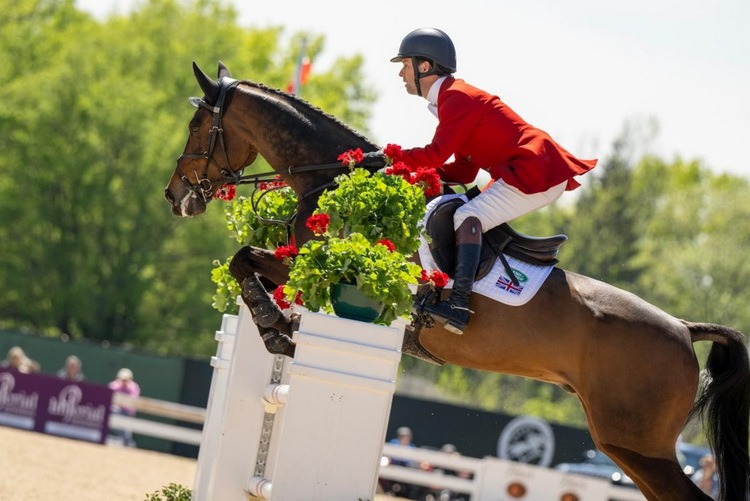
Harry Meade and Et Hop du Matz. (Amy Dragoo photo)
That means he was the only rider to finish on his dressage score. He had moved up with Et Hop du Matz from being seventeenth in the first phase on 34.2 penalties. He was thrilled with his results and his experience in the Blue Grass.
Events such as Kentucky offer “a motivation for these big moments,” said Harry.
“There’s very few places like this that make the hairs on your neck stand up and this is one of them,” he noted.
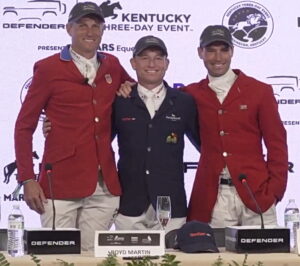
Three great riders: Boyd Martin, Michael Jung and Harry Meade.
Michi never fails to graciously mention his gratitude to Chipmunk’s sponsor, the fischer group, and his family, with his parents and wife on hand to support him, as well as thanking his team that keeps everything running.
And even at age 17, Chipmunk is running just fine. While Michi doesn’t plan on taking him to Britain’s Badminton 5-star in 10 days time (said with a smile), he notes the horse “is looking super-strong…better and better and better.”
Chipmunk has a good share of thoroughbred blood from Heraldik, his dam sire, which is a big help in keeping him fit.
The big question is whether he can do the world championships at home in Aachen, Germany, next year.
“At the moment,” said Michi, “he has a really great feeling. You can feel that the horse is really motivated (in) what he’s doing.”
How long can he go?
“ Hopefully, a few more years,” the rider maintained.
Boyd called Michi “an inspiration to my riding,” noting he has even tried to copy him.
“I’ve never seen a rider who is so good in all three phases,” he pointed out.
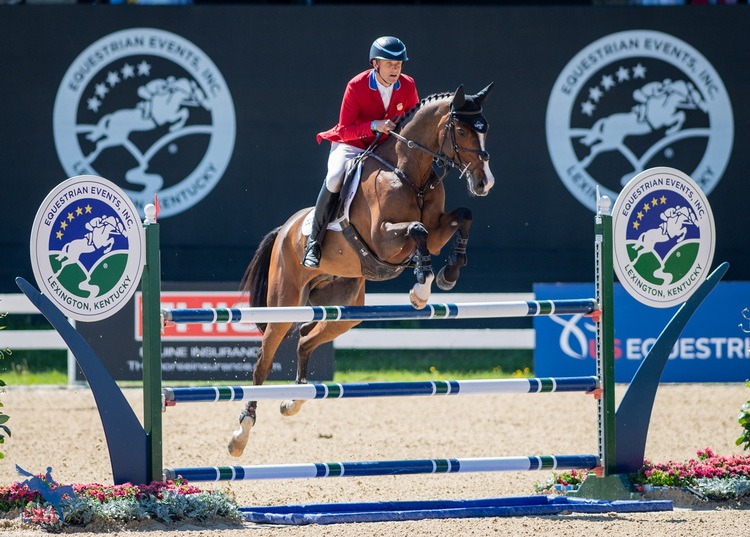
Boyd Martin and Commando 3. (U.S. Eventing Association photo)
For his part, Boyd appreciates the “freakishly talented animals” he rides, saying he was (understandably) “very, very pleased” with his three mounts.

Boyd’s wife, Silva Martin, and their sons supported their main man from the ringside kiss-and-cry stand.
He had questioned whether Commando (known as Connor at the barn) had the “guts and the heart to get through an epic competition like this.
“After going through this event, i think he could be a career-changing horse. He’s beautifully bred with plenty of thoroughbred and he’s strong in all phases. So I think this is just the beginning.”
Boyd added, however, that the Holsteiner “hasn’t been the easiest horse to ride”
At the same time, “He’s got amazing quality; I knew right from the get-go he was a special horse. It’s taken me a fair bit of time to get there, but he’s arrived now.”
click here for 5-star results
In the Cosequin 4-star Short that runs concurrently with the 5-star, Will Coleman won for the second year in a row. Riding Off the Record, he, like Michi, was a wire-to-wire victor.
A rail down in the show jumping made his 33-penalty score perilously close to Phillip Dutton’s runner-up, Possante, on 33.9, but close doesn’t count.
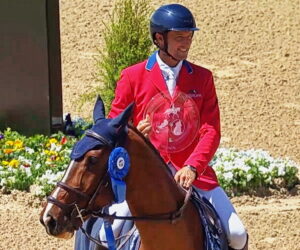
Will Coleman collected his second trophy in a row in the 4-star Short.
“I did hear the rail fall,” recalled Will, “and I said, ‘`Now I really have to think about my clock.’ I hustled a little bit.”
Timmy, as the16-year-old Irishbred gelding by Arkansas is called at home, was up to the task.
“The truth is, the horse has gotten this far in the sport with grit and determination and just try. He showed all those things to come home with no more penalties and keep us out in front. I’m just happy for the horse that I didn’t let him down,” said Will.
He mentioned how much he appreciated the course designed by Steve Stephens.”It’s important that every day matters at a three-day event. The show jumping designer has a lot to do with finishing off on a good note.
“I thought he set a really great test.”
Will didn’t have the best year in 2024, missing out on the Olympics when his horses had some issues. So he relished the way things went in Kentucky and was so relaxed he even took a nap before the show jumping.
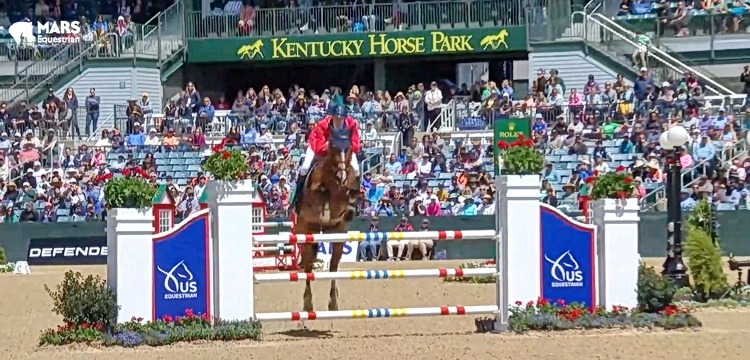
Will got support from the enthusiastic fans at the Rolex Arena.
“I thought it was an exciting day. I really just enjoyed the whole weekend,” he said with a smile.
click here for the 4-star results
Meanwhile, in Saturday night’s $400,000 Split Rock Jumping Tour Kentucky International grand prix, first-to-go Kent Farrington issued a challenge none of the others in the nine-horse jump-off could match.
The world number two-ranked rider and his ever-improving Greya set an unmatchable mark of 42.930 seconds that forced a few of his rivals to make risky turns that paid off in refusals. Second place went to Ireland’s Shane Sweetnam on James Kann Cruz in 45 seconds, followed by whiz kid Mimi Gochman in 46.060 on Inclen BH.
Kent, a U.S. Olympic medalist who also was the alternate in Paris last year, said of his mare, “She’s incredibly fast, super careful and a fighter. She’s a real winner in her heart and an incredible horse.” He believes that her assets make her “the quintessential modern show jumper.”
The grand prix was a 5-star for the first time at the park.
Click here for grand prix results
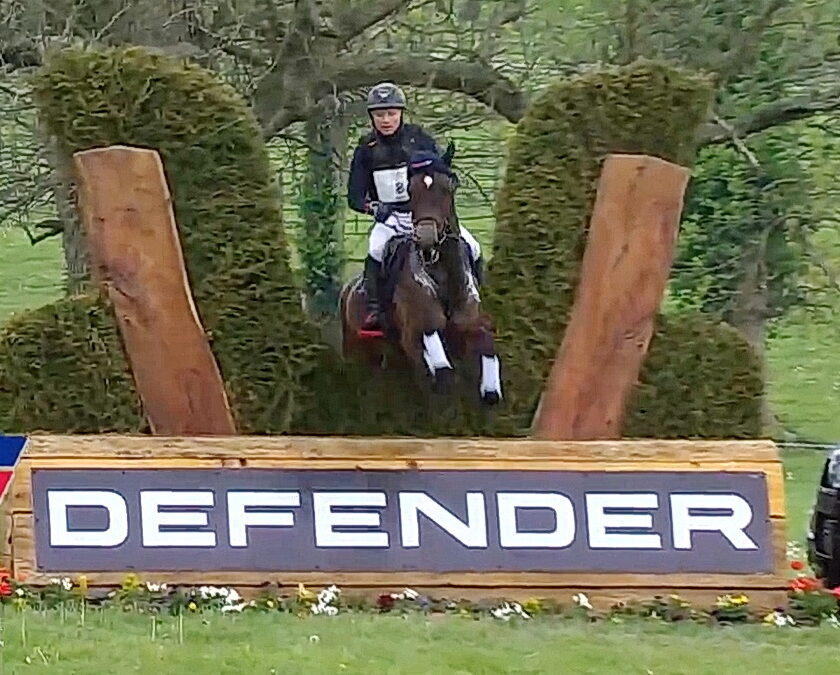
by Nancy Jaffer | Apr 26, 2025
Hard to believe, but German superstar Michael Jung fell just short of perfection on the cross-country course at the Defender Kentucky 5-star three-day event Saturday afternoon.
The Olympic multi-gold medalist and the superlative fischerChipmunk FRH finished 2.4 seconds over the 11-minute, 20-second optimum time along the marvelous route that Derek di Grazia designed at the Kentucky Horse Park. They stand on a mere 21 penalties going into Sunday’s show jumping finale.
“It was a bit of hard work,” Michi reported matter-of-factly about his trip, but then, there was no reason for him to rush.
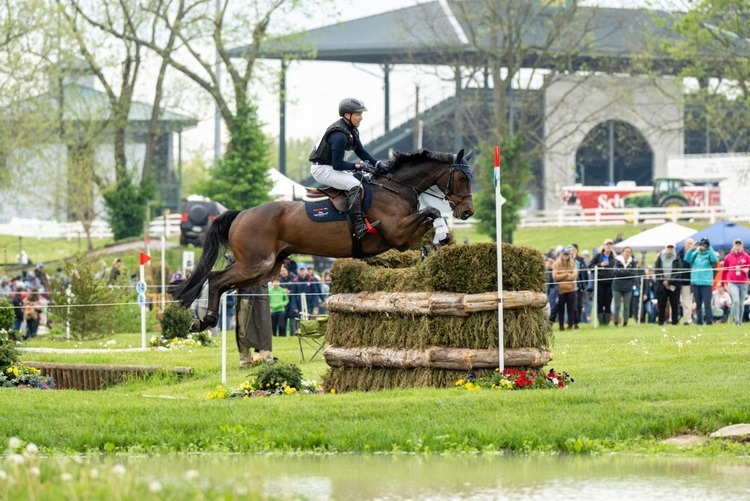
Michael Jung and fischerChipmunk. (Amy Dragoo photo)
The comfortable 7.4 penalty lead he held over the USA’s Boyd Martin on Commando 3 after day two of dressage Friday had expanded to 11.8 penalties, giving him breathing room to knock down two rails and collect a few time penalties, if necessary, in Sunday’s show jumping finale. Under that scenario, he would still win his record fifth Kentucky 5-star, no matter how Boyd fared.
Michi was effusive in praising fisherChipmunk, calling the 17-year-old Hanoverian “an amazing horse,” and who could argue with that?
“He’s super to ride in the dressage, super calm. If you go to the cross-country, he’s full of energy,” said Michi about the son of Contendro I.
“He has very big strides, he’s very honest, he’s very well with me, I really can trust him.”
Michi conceded the horse “felt a bit tired some places” on cross-country, “so I give him a bit of time.”
It wasn’t a big break, but Michi was aware of exactly where he could offer some breathing room.
“I know I was behind the (optimum) time, but he was really, really good galloping to the end of the course,” he commented.
One would be tempted to think that if Michi couldn’t make the time, no one could. But Great Britain’s Harry Meade managed to do it – twice! Harry is third on Et Hop du Matz “who gave me a peach of a ride” that kept him on 34.2 penalties, moving up from seventeenth place after dressage. He is also fourth on Graffenacht, William Fox-Pitt’s former mount, who was eighteenth after dressage but added nothing to her 35.2 penalties as she traveled around the scenic course.
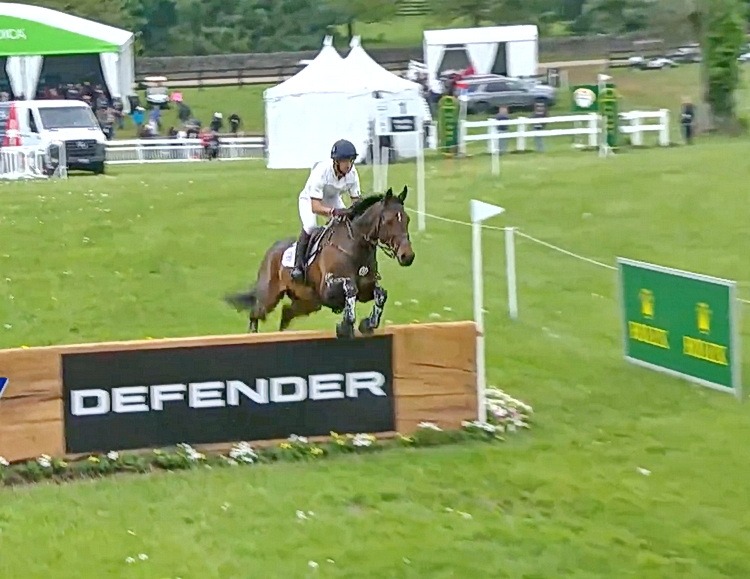
Harry Meade and Graffenacht.
Harry conceded he “doesn’t know her at all” and didn’t have a proper cross-country school on the mare before crossing the Atlantic ocean “so I was coming in here a bit blind. I was actually questioning as to whether I’d run her as of 11:30 this morning. Then I thought I’d just start out and see how she was.”
So how was she?
“She was magic,” he enthused.
He basked in the glow of the day and the way his horses went. The rider offered them an opportunity to slice a few instants here and a few there off their time, even though he wisely made a last-minute decision to take the long way out of the Head of the Lake with Graffenacht. But he couldn’t have asked more from either mount.
“I love these two,” said Harry. He’s the son of the late legendary British team eventer, Richard Meade, who won three Olympic gold medals.
Boyd, whose energy never seems to flag, rode three horses. He is seventh on Federman B (40.2 penalties) and ninth on Luke 140 (44.7) in addition to being second on 32.38 penalties with the 12-year-old Commando 3 (known around the barn as Connor).
Riding three horses on a challenging course is “tiring and nerve wracking,” he said, but he is uplifted by his horses’ efforts.
“I have so much admiration for their heart and desire,” he said.
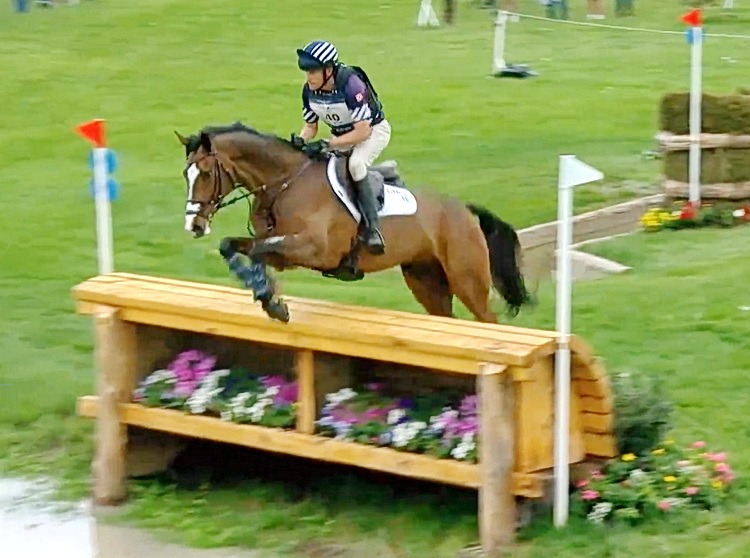
Boyd and Commando 3 on cross-country.
“I thought it was a tough course, and the ground with all the rain we got yesterday was quite holding and tiring. My first horse, Bruno (Fedeman B) got tired early and I was a bit too cautious on Luke. And then I thought, `I’ve got the young horse last, he’s young and naïve, let’s go for it.’ Connor was fantastic.”
The pressure is ” bloody nerve-wracking, especially when you go in the afternoon. I don’t sleep that well the night before, trying to go through the course and trying to make sure I understand how I want to jump each jump. As you get closer and closer, for me, you’ve sort of got to make a deal with yourself that you’re going to have a crack at it because it’s very easy to talk yourself out of not going for it.
“Leading up to the cross-country, I’m always saying, `What the hell am I doing this for?’ When you’re finished with it, you’re like `Okay, where’s the next one?’ It’s a real feel of satisfaction that you’ve trained your horse to get to this place.”
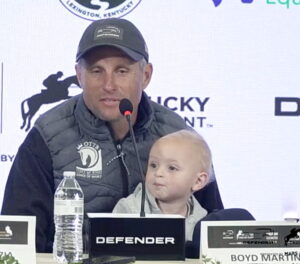
Boyd Martin with his toddler son, Koa, who wanted to be part of the press conference. (Where did he get his love of attention?)
Boyd has a huge cheering section wherever he goes. His charm and sense of humor have won him lots of fans.
“I love eventing in America,” said Boyd, citing “the best crowds in the world.”
Looking ahead to the final test in the Rolex Arena on Sunday, he cited his luck in having Olympic show jumping team gold medalist Peter Wylde to coach him.
And as far as his trio of equine stars goes, he observed, that they are “all good show jumping horses. I just have got to give them a good ride. Hopfeully, they recover well, get a good night’s sleep and come prancing out of the stall tomorrow.”
Tom McEwan of Great Britain, ranked world number one, was 0.02 penalties behind Boyd after dressage with Brookfield Quality. But 10.4 time penalties have put him fifth with a 36.6 total to this point.
“It his first proper, proper 5-star,” said Tom about his Irishbred horse, explaining an outing to the Pau, France, 5-star last fall was difficult because of the mud and wind that meant the cross-country had to be cut to eight minutes optimum time.
In Kentucky, the horse nicknamed Nervous Norris “tried his heart out; he’s straight as a die. He’s been pretty amazing and for the amount of riding I was doing, I felt like I was a jockey for Willie Mullins,” Tom joked, referring to a top British steeplechase trainer.
Click here for 5-star results
In the 4-star Short that runs concurrently with the 5-star, U.S. team veteran Will Coleman and the very experienced 16-year-old Off the Record kept their lead from dressage with the fastest clocking, just 7.2 time penalties. No horse made the time, but everyone in the top 20 was free of course faults, such as refusals and frangible pin problems.t
When Will walked the course, like the 5-star a Derek di Grazia creation, he knew it would be tough to finish without time faults.
“It was not surprising to me that no one got that close to it,” said Will,
Speaking of his horse, “He gave me everything he could today. He stands on 29 penalties.
Phillip Dutton, who led after day one dressage with Denim, is second with Possante, who also was second after dressage was copleted. He has 33.5 penalties, which gives Will a rail’s worth of breathing room in Sunday’s show jumping. Denim is on 37.2 penalties, keeping his third place ranking.
The second-fastest time belonged to Canada’s Jessica Phoenix, who had just 8 penalties on Freedom G.S. to be fourth.
Click here for 4-star results
In Saturday night’s $400,000 Split Rock Jumping Tour Kentucky International grand prix, first-to-go Kent Farrington issued a challenge none of the others in the nine-horse jump-off could match. The world number two-ranked rider and his ever-improving Greya set an unmatchable mark of 42.930 seconds that forced a few of his rivals to make risky turns that paid off in refusals. Second place went to Ireland’s Shane Sweetnam on James Kann Cruz in 45 seconds, followed by whiz kid Mimi Gochman in 46.060 on Inclen BH.
Kent, a U.S. Olympic medalist who also was the alternate in Paris last year, said of his mare, “She’s incredibly fast, super careful and a fighter. She’s a real winner in her heart and an incredible horse.” He believes that her assets make her “the quintessential modern show jumper.”
The grand prix was a 5-star for the first time at the park.
Click here for grand prix results
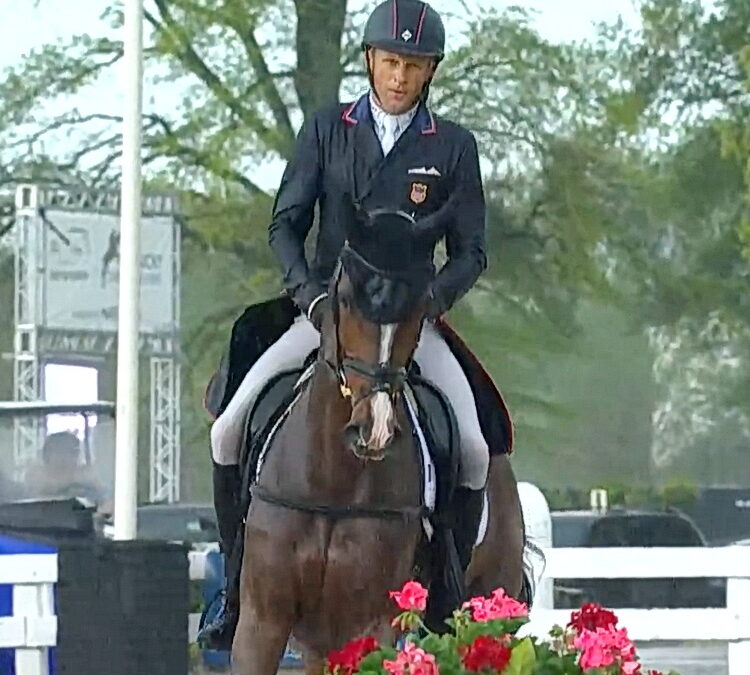
by Nancy Jaffer | Apr 25, 2025
Riding amidst the downpour that wrapped up day two of the Defender Kentucky 5-star eventing dressage on Friday, Boyd Martin did not flinch during the soaking that drenched much of his performance with Commando 3.
That type of heroic perseverance, for which Boyd is known, made him not only the top American in the competition so far, but installed him in second place on 26 penalties. That’s just 0.02 penalties ahead of world number one-ranked Tom McEwen from Great Britain and Brookfield Quality in third.
Both are chasing Olympic champion Michael Jung of Germany with fischerChipmunk FRH. Michi will be trying to set a new 5-star record at the Kentucky Horse Park if he finishes on his Thursday dressage score of 18.6 penalties, which would beat his landmark 20.1 penalty victory in the 2022 event. A victory would also make him the only rider to have topped the standings at Kentucky five times.
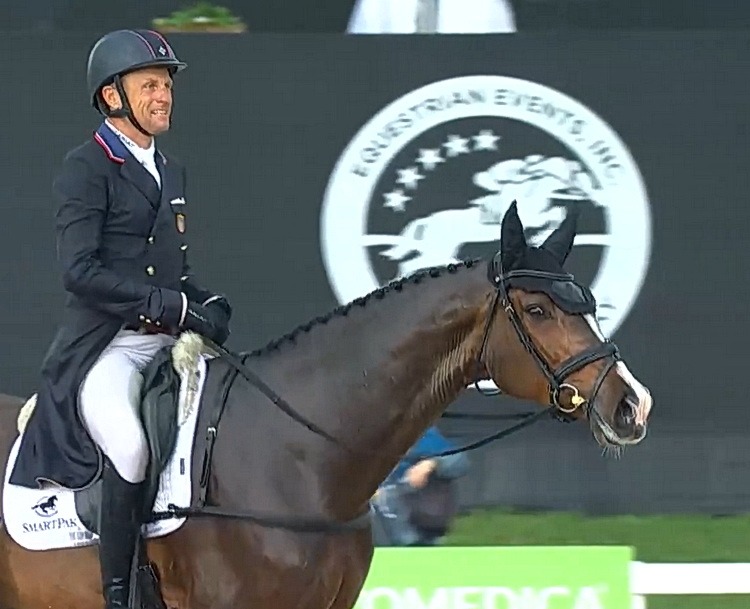
After a soaking during his dressage test, Boyd Martin smiled for a job well-done with Commando.
Commando, a 12-year-old Holsteiner known as Connor (like his sire, Connor 48), was just one of Boyd’s three rides in the event. He is sixth with Luke 140 (27.9) and eleventh with his Olympic mount, Federman B (29.8).
While doing a dressage test through a curtain of rain wasn’t comfortable, Boyd said the weather actually helped him with Connor.
“He sort of put his head down a bit further. In sport, there’s some things you’ve got no control over…I just tried to stay in the moment. Commando 3 is a champion horse and he stayed focused,” said the Pennsylvania resident, noting Connor can be spooky.
“Maybe it distracted him a bit,” Boyd theorized about the rain.
“But he went in and did a good job in there.”
After his final salute, Boyd said with a smile that he was “very relieved I could go and get some dry underwear on.”
The brief discomfort was worth it for the result.
He considers Kentucky as “one of these premier 5-stars that I live for. I’ve been thinking about this event since the beginning of the year, and these horses, everything has been pointing toward this moment, thousands of hours of practice and galloping and lead-up competitions and we’re here.”
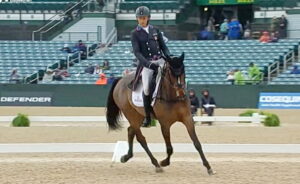
Boyd Martin with Luke 140, who is sixth.
Tom characterized his mount, who he took over from his compatriot Piggy March in 2022, as “such a cool horse.”

Tom McEwen and Brookfield Quality.
Added Tom, “he’s a bit nervous, but he really tries and puts everything he can into it. I was just delighted with the test. He did some real nice work.”
Tom, who has just missed winning Kentucky in the past, had some issues in his test during the half-pirouette right and the transition to the collected trot, which earned him several marks of 5.
He noted it was “a shame about a little mistake halfway through, but mistakes happen.”
Of his Irishbred gelding’s performance, Tom noted, “When he went in there, his eyes came out on stalks a little bit and he sort of froze and held his breath.” However, “The more the test went on, I felt the better and better it got.”
Fourth place with 27.1 penalties belongs to an unsung Kentucky newcomer, Germany’s Libussa Lübbeke aboard Caramia 34. The mare is a homebred ridden previously by 24-year-old Libussa’s brothers, who were on hand to cheer for her.
Libussa trains at the Bundeswehr Sports School for top-level athletes at the country’s Warendorf center (think of it as Germany’s version of what Gladstone used to be in the old U..S. Equestrian Team days).
She wears the very sharp uniform of the German air force, and gave a smart military salute to the judges when she presented her mare for the horse inspection on Wednesday.
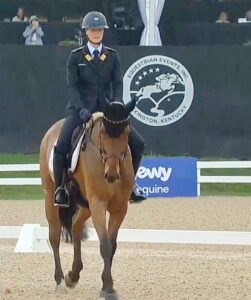
Libussa Lübbeke and Caramia 34.
“It’s amazing to be here in this arena with this horse. The whole family is here. To be at this event is like a once-in-a-lifetime experience,” she said.
Of her mare, Libussa noted, “She’s unique and tries her heart out for me. It’s the best horse to try the first Kentucky.”
Discussing Derek di Grazia’s cross-country course that is the focus of Saturday’s program, the German observed, “It looks amazing. It’s a bit different to European courses. All technical questions are clear; it’s a course to ride forward.”
Click here for 5-star results
In the 4-star Short that runs concurrently with the 5-star, Will Coleman and the veteran Off the Record were marked at 21.8 penalties to supplant first-day leader Phillip Dutton. Phillip actually supplanted himself as well. Riding Possante to a 23.1-penalty mark, he moved into second place ahead of Denim, who was the best on Thursday with 25.6 penalties. Click here for 4-star results.


































